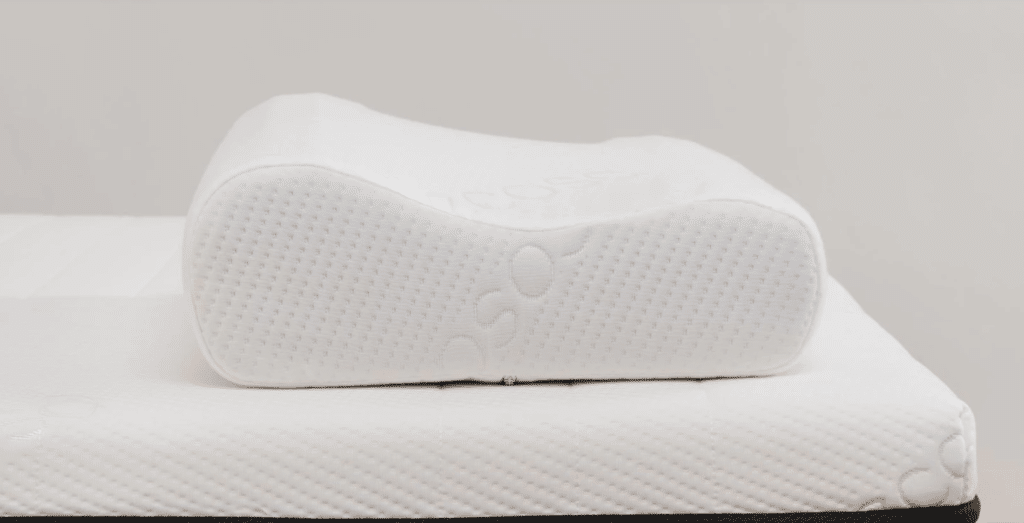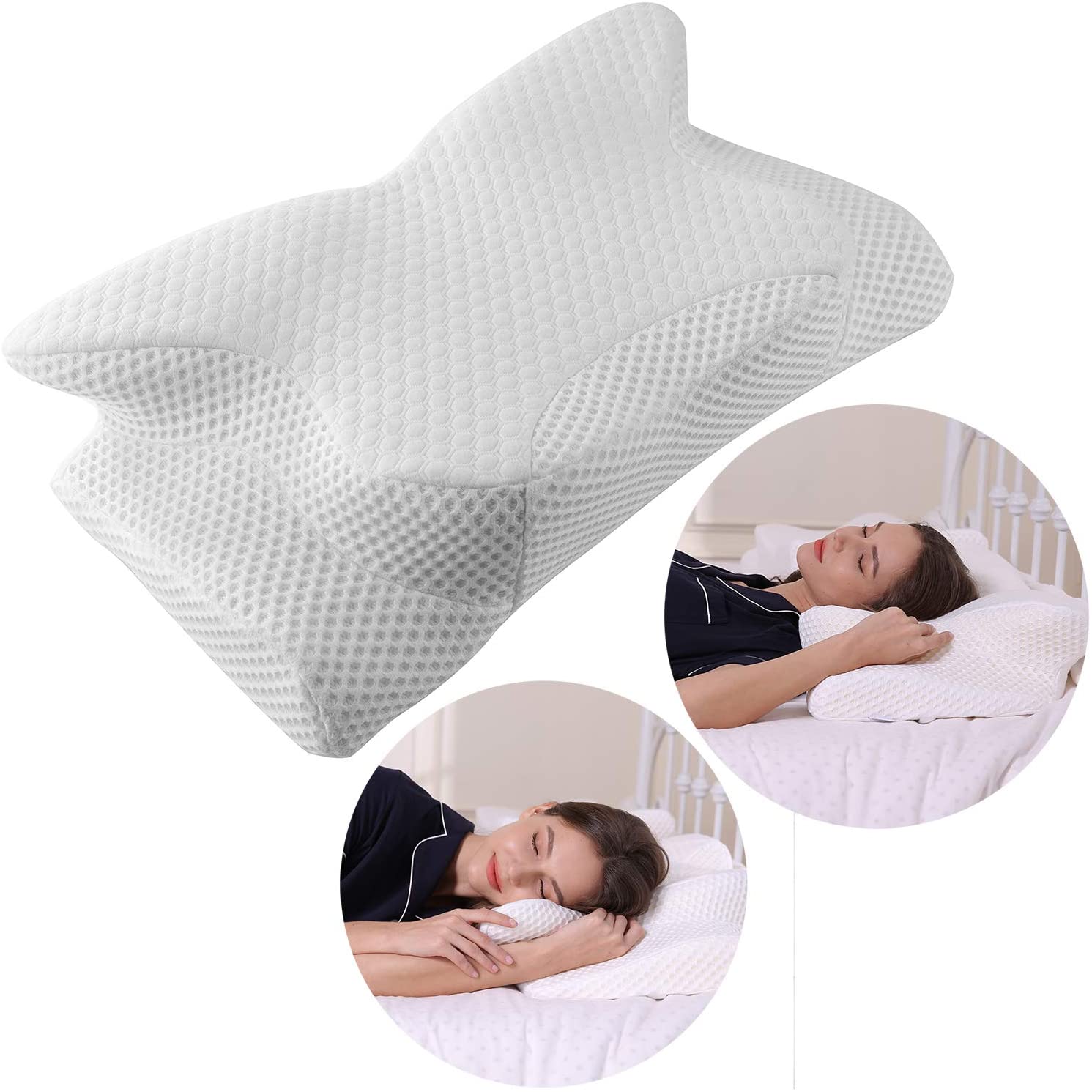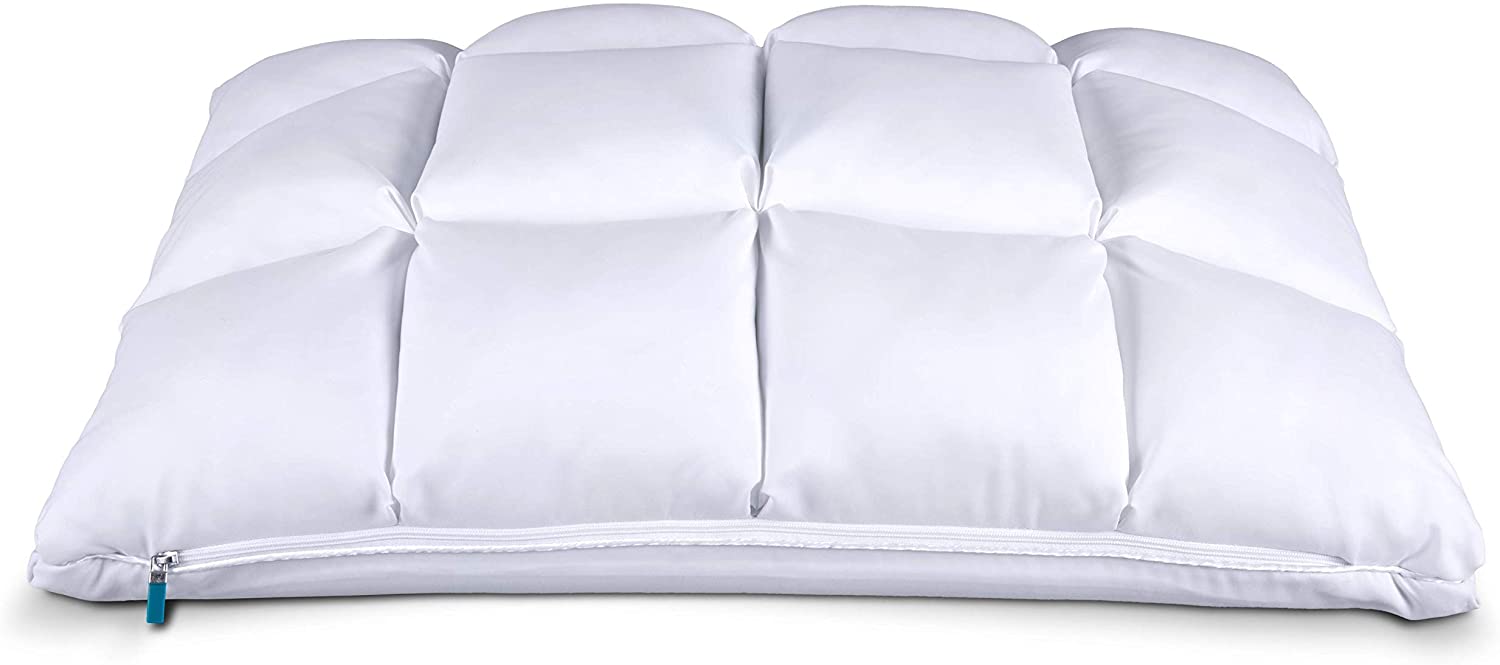Menu
Late-night shoulder pain is probably the most common symptom in patients with shoulder conditions such as bursitis, tendonitis, tendinosis, impingement, rotator cuff tears, and capsulitis. All of these conditions generate a certain level of shoulder stiffness and inflammation.
But, if you have no history of shoulder problems, the most probable cause has to do with your sleep position. People who sleep on their side tend to frequently sleep on their shoulder, to some extent causing their rotator cuff tendons or shoulder bursae to become pinched. The pain may not happen right away, but after several hours, this position generates an inflammatory response. This inflammation of the pinched structure causes you to feel pain when you wake up.
So, why do you experience shoulder blade pain at night and what can you do to alleviate it? Let’s talk about the connection between your sleeping position and shoulder pain, as well as few essential tips and the best pillow to relieve shoulder blade pain at home.

Although numerous shoulder complications can cause pain, the most common cause of shoulder blade pain at night originates from rotator cuff tendinitis. It usually is caused by inflammation of the shoulder tendons leading to swelling and pain. This condition can be caused by many factors, such as:
Rotator cuff tendinitis affects millions of people in the U.S. every year and is also a major cause of shoulder pain when sleeping.
Osteoarthritis, frozen shoulder, and shoulder dislocation are also a few of the other causes of shoulder pain at night.
Our posture not only affects us during the day but including when we sleep. Certain sleeping positions can put excess strain on the shoulder muscles, resulting in irritation and stiffness. When you sleep in a position that puts pressure on your rotator cuff, the added stress can cause tearing, which may develop into tendonitis or shoulder impingement syndrome. These conditions occur when your bone compresses against your tendons.
Throughout the day, the shoulder is functioning while in a vertical position. The tendons contract and are pulled downward by gravity, which allows space to be produced in the muscle groups in the shoulder. This provides additional space for increased blood flow and oxygen that relieves stiffness and discomfort.
As you lay down to rest at night, you are normally in a horizontal position. This eliminates the effect of gravity and allows the shoulder muscles to decompress. The absence of movement and the relaxation of the muscles allows the fluids in your joints to settle and minimizes the flow of blood, allowing the joint to become congested. People also end up lying on their shoulder while sleeping, which can compress the joint even further, and thus, making the inflammation worse.
If you have mild shoulder blade pain, at-home solutions can often resolve the problem. Here are some effective ways for shoulder blade pain relief you can do at home.
One of the best ways to relieve shoulder blade pain at night is to find the right sleeping position for you. Tossing and turning at night is normal for some, but can agitate your shoulder if you land on it improperly. Sleeping on the opposite shoulder can help bypass this pain, but avoid sleeping on your back.
If the pain persists, you can always try wrapping your arm or wearing a sling to help sustain and prevent movements during sleep. Sleeping with a pillow under your knees can help also alleviate any associated back pain.
Exercising a few hours before bed increases blood flow throughout the entire body. This can relieve pain, as well as relaxes you enough to ease sleeping troubles. Try some low-impact exercises and then allow your body to cool down again before sleeping.
Additionally, certain shoulder stretches can help reduce the tension and pressure accumulated during the day. Shoulder stretches are an easy option as it only takes a few minutes to perform. Stretching provides huge health benefits such as increasing flexibility, range of motion, and blood flow. It can easily be done at home and require no special equipment.
You might not realize but you could be hindering your sleep when you're spending excessive time on your phone.
If you’re a side sleeper, you might need a pillow that allows your head and neck to rest in a relaxed neutral position. Though you might also find it easing if you sleep with another pillow in between your knees. The extra pillow helps maintain your spine and hips in a more upright position, which can alleviate back pain.
If you're a stomach sleeper, a very soft, thin pillow under your pelvis may be useful too.
A night of deep sleep is essential after a long, hectic day so that you may wake up refreshed and rejuvenated. Sleeping can often be an uncomfortable experience when you’re dealing with issues like body aches or strain.
Those who are suffering from shoulder blade pain may require certain pillows that not only relieve the pain but also promote a night of peaceful and comfortable sleep.
We’ve gathered five of the best sleeping pillows suitable for shoulder blade pain along with a comprehensive buyer’s guide to making your journey to the sleep of your dreams effortless.
ComfyCentre's Memory Foam Pillow offers a unique, aesthetic design that perfectly fits in modern homes. Its ergonomic design follows your cervical vertebra, relieving the pressure on your neck and promotes better alignment while you sleep as it supports the natural curve of your neck. What makes the ComfyCentre memory foam pillow stand out among other memory foam pillows is that it retains its shape. It provides you a higher density and higher quality in comparison to other brands. The breathable memory foam cover eliminates the need of fluffing your pillow in the middle of the night to get the right feel. Moreover, it gives you an air-permeable pillow cover as well.
This pillow is perfect for hot sleepers as its breathable design encourages warmth and moisture to disperse from the pillow’s surface. This pillow is surely worth its price.

This pillow from Ecosa features adjustable height pads, a breathable 3D structure, a removable cover, and activated charcoal memory foam.
The removable cover allows an effortless quick cycle in the washing machine to refresh it. Aside from that, the activated charcoal memory foam promotes odor control and antibacterial protection.
This pillow is perfect for hot sleepers as its breathable design encourages warmth and moisture to disperse from the pillow’s surface. This pillow is surely worth its price.

The Cosium Cervical Pillow is another great quality pillow for side and back sleepers. This pillow uses premium memory foam that provides a firm platform to place your head upon. It relieves the soreness of muscles and tendons by providing a solid surface under your head. This pillow is a suitable choice for neck and shoulder pain.
If you have cervical issues, you can utilize the higher side to sleep. While those who sleep at the back or side can use the lower side to sleep comfortably. In addition, this pillow comes with a removable pillowcase for ease of washing. It has a breathable fabric and stuffing that allows air to flow within. This pillow is also made up of safe and non-toxic material.

The Leesa Hybrid Pillow is popular for its remarkable cooling technology, designed to offer a cooling effect all night long. It is filled with a ventilated gel that allows the air in and maintains a chilling environment.
This pillow comes with a zipper and a down-like filling, making it lightweight and fluffy and offers a plush feel. It is designed to provide maximum grip and support to your muscles and ligaments to help alleviate the pain.

The Eden Adjustable Pillow is an excellent combination of comfort, support, and functionality. It features a soft gel-infused memory foam that allows you to feel cool all night long. The ergonomic design offers great support to your sleeping position, relieving the pain on your shoulder or neck and reducing stress. This adjustable pillow is versatile due to its adjustable filling that can be added or discarded to adjust the height and weight according to your preferred sleeping position and convenience.
Furthermore, this pillow is a vegan product free from animal products. It is made up of Lulltra fabric and a combination of rayon and viscose that's dust-resistant.
Your sleeping position can produce a big difference when it comes to shoulder blade pain. Sleeping in the wrong position can often lead to a sore shoulder upon waking up that hinders you from doing your daily activities.
Sometimes, shoulder blade pain during sleep is a symptom that derives from existing conditions such as shoulder impingement, bursitis, rotator cuff tears, tendinitis, frozen shoulder, and arthritis.
Nevertheless, there are few steps you can practice to help reduce shoulder pain while sleeping with better sleeping positions.
One of the most effective positions for shoulder blade pain relief is sleeping on your back. This position allows a neutral and balanced distribution of the weight. It also supports your neck, head, and spine, allowing your body to relax in a stress-free posture. When you sleep on your back, your shoulders are loosened rather than being compressed in various directions. Despite the benefits, only eight percent of sleepers are practicing this sleeping position.
If you're already a back sleeper yet still struggles with shoulder blade pain, try placing a pillow in your armpit area to prevent yourself from leaning on your shoulders during sleep. The right thickness of the pillow under your head is also essential. It prevents your neck from bending up to the ceiling, neither your chin is tucked downwards. Once your neck and head suffer from imbalance or pressure, your shoulders will be affected due to its interconnected muscles.
In some cases, sleeping on your sore shoulder can be beneficial and helps alleviate the pain. This is also handy for people who find it challenging to sleep on their backs. To sleep on your sore shoulder, turn to your side and place a pillow below your mid-hips and back. Some people have a wider pelvis than their shoulders, so placing an extra pillow will balance out the position of the body and support restful sleep.
You’ll also need to place an extra pillow beneath your head considering your body is elevated. This position can provide comfort and relief, at the same time aligning your spine correctly.
Another alternative is to roll back or lean. This places pressure on your shoulder blade rather than the painful part of the shoulder. Perform this by placing a pillow behind your back to support the place. These positions may not be suitable for every case of shoulder pain so you might need to seek a health professional to find the most suitable sleeping position for your situation.
This sleeping position requires a pillow on top of your stomach and another pillow in your armpit area to help push, assist and restrict pressure on the sore shoulder. Your hand or elbow shouldn't rest too high, as this can prevent proper blood flow and generate numbness in the arm. Place another pillow between your legs on your upper hip. This releases the stress from the pelvis, placing the body in a neutral position while you sleep. This position also helps the pelvis, spine, and shoulders align in addition to shoulder blade pain relief.
If you have shoulder pain while sleeping, let us know! We can recommend you a suitable product to help you sleep better. But in the meantime, make sure your shoulder pain isn't another underlying problem. Try out some of the advice mentioned above to help alleviate some of the pain. Once the shoulder pain interferes with your daily activities or persists a few weeks after, consult an orthopedic expert for an accurate diagnosis.